7 MIN READ
Corn Earworm in Corn
July 30, 2022
- Corn earworm (CEW) has one of the widest host ranges of any insect pest, with over 15 cultivated plant hosts. It goes by many names, including cotton bollworm, soybean podworm, sorghum headworm, tomato fruitworm, and vetchworm.
- Responsive pest management tactics are difficult to utilize in field corn when CEW attacks the ear, as sampling techniques based on CEW abundance at this stage of field corn development are not practical. While CEW can cause damage during the vegetative stages of corn growth, it is rarely enough to warrant an insecticide application.
- Using preventative pest management tactics, such as corn products containing specific Bacillus thuringiensis (Bt) proteins that target CEW, can protect the plant in both the vegetative and reproductive stages.1
IDENTIFICATION
Corn Earworm
The larval stage of CEW can occur in a rainbow of colors, from green to dark brown. Often, they can be confused with other species, such as the larvae of fall armyworm, true armyworm, European corn borer, southwestern corn borer, or western bean cutworm.
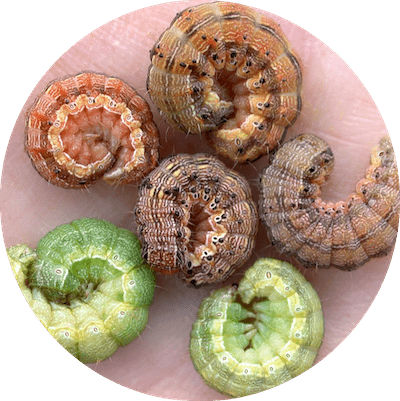
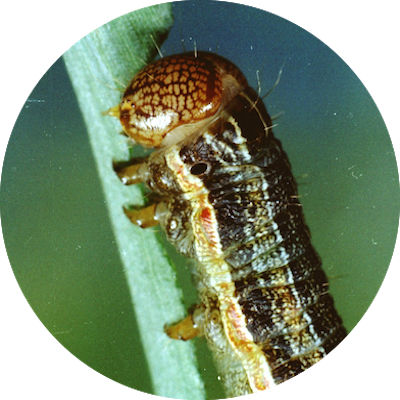
Fall Armyworm
Fall armyworm larvae have a prominent, white, inverted Y-shaped mark on their head capsule. The larvae vary from light tan or green to almost black in color.
True Armyworm
True armyworm have a gray or greenish-brown head covered with a network of lines.
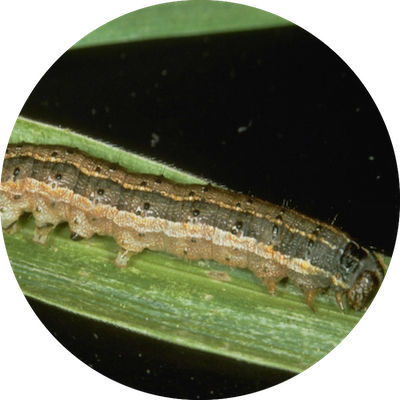
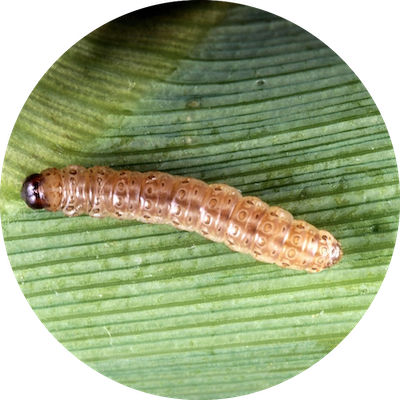
European Corn Borer
European corn borer larvae have a dark-brown to black head. The larvae have smooth, dirty-white colored skin, often having a pinkish tinge, with two brown spots on each segment of the body.
Southwest Corn Borer
Southwestern corn borer larvae have a brown head and are dull white with a pattern of raised black spots on the body.
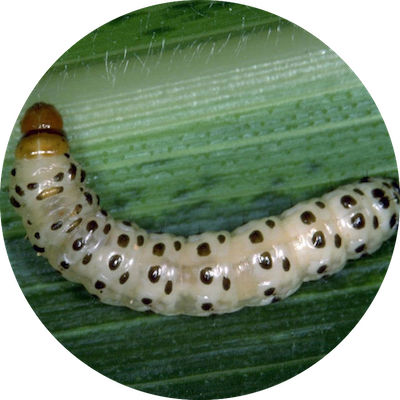

Western Bean Cutworm
Western bean cutworm are tan with a darker, faint, diamond-shaped pattern on their back, and two short, dark stripes immediately behind their head. Larvae turn pinkish tan or pale brown as they mature.
LIFE CYCLE
General
Over the duration of her life span, a female deposits 500 to 3000 eggs on corn and other host plants. Eggs usually hatch within a week and larvae feed on the host plant for 3 to 4 weeks before pupating in the soil. While there may be more than one egg deposited on an individual ear, the larvae become aggressive and will attack each other so it is common to only find one CEW larva on an ear. Occasionally, one may be found at the butt of the ear and one at the ear tip.
Midwest
The CEW generally does not overwinter in the Midwest, as the survival of the overwintering pupa in the soil is reduced when temperatures are 30° F or less. The majority of moths in the Midwest migrate from southern states in early summer. Generally, there are two full generations per year in the Central and Northern Corn Belt. The second generation usually coincides with the reproductive stages of corn. In the Southern Corn Belt, overwintering moths usually emerge in late April and migrating adults begin to arrive in June. There are three full generations in the Southern Corn Belt, with both the second and third generations occurring during the reproductive stages of corn.
South
The CEW is the most common lepidopteran pest of corn in the southern United States.2 There can be as many as 7 generations in South Texas and 4 in North Carolina. Generally, the first and second generation CEW larvae attack whorl-stage corn in the Mid-South and later generations are found in the ear, usually at the tip.1 A multi-state study conducted in the Cotton Belt indicated that corn was the major host plant in July and continued to be until August, when the other hosts became more favorable.3 Corn again became preferred in mid to late September.3
PLANT INJURY AND SCOUTING
The first generation usually coincides with the vegetative stages of corn. Larvae feed in the whorl and as the leaf emerges, the injury will result in ragged-edged holes that expand in size as a result of the leaf expanding. The larva will deposit frass (insect excrement) on the leaves giving the leaf a dirty appearance. Subsequent generations correspond with the reproductive stages of corn where the eggs are deposited individually on the silks. The larva usually will enter the ear via the silk channel. As the larva feeds at the ear tip, it clips the silks from the ear resulting in them being easily removed and dropping from the tip completely. Ear tip feeding by itself seldom results in significant yield loss, but it may provide an opening for fungal pathogens.
MANAGEMENT
Whorl-stage infestations can be common in areas where CEW overwinters and in northern areas when the female migrates earlier in relation to corn plant development, but this injury rarely reduces yield.1 In the South, the highest infestation is usually associated with the earliest planted corn. The economic treatment threshold for CEW in whorl-stage corn is when 50% or more of the plants are infested. Insecticides can be used but they must be applied in a way that maximizes the amount of insecticide entering the whorl to be effective.
In the Cotton Belt, ear infestation rates can reach 100% during outbreak years. However, in field corn, yield losses do not usually occur from ear feeding if the crop is planted at the appropriate time. Late-planted field corn and other corn crops (white, popcorn, sweet corn) can experience economic injury. Applying insecticides on a spray schedule can help reduce infestations of CEW in sweet corn when based on pheromone trap captures; however, it is not cost effective for use in field corn.4
Because of the challenges of using responsive pest management tactics (responding to an occurring economic infestation) to manage CEW in field corn, preventative pest management tactics (preventing an economic infestation) are recommended, such as tillage to expose overwintering pupa in the soil, hybrids with extremely tight husks, and early planting. The use of specific Bacillus thuringiensis (Bt) proteins that target CEW have also been developed. Products containing the Vip3Aa20 protein, such as Trecepta® corn, provide excellent control of CEW.5,6
SOURCES:
1Reisig, D. 2015. Corn earworm. North Carolina State University Extension. https://entomology.ces.ncsu.edu/field-corn-insect-corn-earworm/
2Reay-Jones, F., 2019. Pest status and management of corn earworm (Lepidoptera: Noctuidae) in field corn in the United States. Journal of Integrated Pest Management. 10(1): 1–9. https://academic.oup.com/jipm/article/10/1/19/5512991
3Jackson, R.E. et al. 2008. Regional assessment of Helicoverpa zea populations on cotton and non‐cotton crop hosts. Entomologia Experimentalis et Applicata. 126: 89–106.
4Boyd, M.L. and Bailey, W.C. 2001. Corn earworm in Missouri. University of Missouri Extension. https://extension2.missouri.edu/g7110
5Pioneer claims suppression of corn earworm with Herculex I; Syngenta claims suppression of corn earworm with Bt11.
6Cry1A.105 and Cry2Ab2 from B.t. controls or suppresses corn earworm.